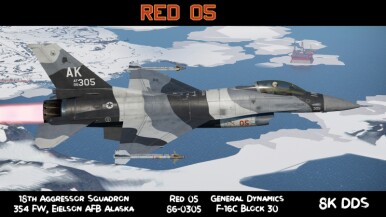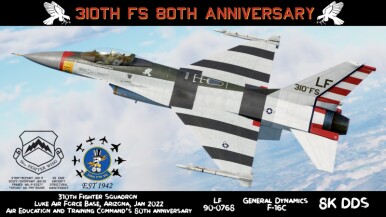



The F-16C was a major improvement over the previous variants of the F-16. The previous Block 42 aircraft weighed 3,000+ lb (1,360 kg) over the early F-16s. To offset the increased weight, General Electric developed the F110-GE-129 which greatly increased thrust at both low and high altitudes. The Block 50 also received the Westinghouse APG-68(v)5 radar (upgraded to the -68(v)7 in later production models) which was much faster and generally more reliable. One of the biggest additions to the Block 50 was the ability to fire new ground attack munitions. The USAF received the first F-16 Block 50 in late 1991 and many more were sent to foreign countries as well.
Introduced in Update "Sons of Attila", the F-16C is an excellent top-tier aircraft. The improved General Electric F110 greatly increases the performance of the Block 50 against enemy aircraft. It excels in dogfighting thanks to its relatively light airframe and better engine. The Fighting Falcon has access to AIM-9M Sidewinders with a smokeless motor and improved IRCCM, making them an incredibly dangerous missile, especially from rear aspect. Players should be more than satisfied with the F-16C Block 50 against both aircraft and ground targets.
flaps
flaps
flaps
brake
| Belt | Belt filling | Armor penetration (mm) at a distance: | |||||
|---|---|---|---|---|---|---|---|
| 10 m | 100 m | 500 m | 1000 m | 1500 m | 2000 m | ||
| HEF-I/API-T/AP-I/SAPHEI | 40 | 36 | 22 | 12 | 6 | 3 | |
| HEF-I/HEF-I/API-T/HEF-I/HEF-I/AP-I | 40 | 36 | 22 | 12 | 6 | 3 | |
| SAPHEI | 37 | 33 | 20 | 11 | 6 | 4 | |
| HEF-I/AP-I/AP-I/SAPHEI | 40 | 36 | 22 | 12 | 6 | 3 | |
| Name | Weight | Slot | ||||||||||
|---|---|---|---|---|---|---|---|---|---|---|---|---|
| 84.5 kg |  |  |  |  |  |  | ||||||
| 84.5 kg |  |  |  |  |  |  | ||||||
| 147.9 kg |  |  |  |  |  |  | ||||||
| 231.3 kg |  |  | ||||||||||
| 57 × | 688.9 kg |  |  | |||||||||
| 19 × | 256.1 kg |  |  | |||||||||
| 21 × | 433.8 kg |  |  | |||||||||
| 21 × | 481.5 kg |  |  | |||||||||
| 226.8 kg |  |  | ||||||||||
| 3 × | 680.4 kg |  |  | |||||||||
| 303.5 kg |  |  | ||||||||||
| 3 × | 722.7 kg |  |  |  |  | |||||||
| 893.6 kg |  |  |  |  | ||||||||
| 893.6 kg |  |  |  |  | ||||||||
| 3 × | 762 kg |  |  |  |  | |||||||
| 2 × | 554.3 kg |  |  | |||||||||
| 1,079.6 kg |  |  |  |  | ||||||||
| 2 × | 506.2 kg |  |  | |||||||||
| 893.6 kg |  |  | ||||||||||
| 4 × | 486.3 kg |  |  | |||||||||
| 2 × | 579.4 kg |  |  | |||||||||
| 987 kg |  |  | ||||||||||
| 2 × | 802.8 kg |  |  |  |  | |||||||
| 6 × | 1,445.4 kg |  |  | |||||||||
| 6 × | 1,524 kg |  |  | |||||||||
| Drop tank (370 gal.) | 100 kg |  |  | |||||||||
| Drop tank (300 gal.) | 100 kg |  | ||||||||||
| Sniper targeting pod | 202 kg |  | ||||||||||












Flight performance | |
|---|---|
Survivability |
|---|
Weaponry | |||
|---|---|---|---|

